During the last year or so several new metal halide lamps have made it into the market, along with some new ballasts recommended for the lamps. This article is a continuation of the series [references 1-5], and the sixth in the series. Included in this article are results from our testing of several of the new lamps and ballasts. Table 1 shows the list of lamp and ballast combinations tested for this article.
| Lamp | Ballast |
|---|---|
| 400W Ushio 10000K | Magnetek Ballast |
| PFO – “HQI” | |
| Venture Pulse Start | |
| “HQI”-Taiwan | |
| 400W Ushio Blue | Magnetek Ballast |
| PFO – “HQI” | |
| Venture Pulse Start | |
| “HQI” – Taiwan | |
| 400W AB 10000K | Magnetek Ballast |
| PFO – “HQI” | |
| Venture Pulse Start | |
| “HQI” – Taiwan | |
| Sylvania Aqua Arc 400W | Magnetek Ballast |
| PFO – “HQI” | |
| Venture Pulse Start | |
| “HQI”- Taiwan | |
| Vion Z6 – 400W | Magnetic Ballast |
| Venture Pulse Start | |
| Xanium 400W | Magnetic Ballast |
| Venture Pulse Start | |
| Vion Z6 – 250W | Magnetic Ballast |
| Electronic Ballast | |
| Vion Z6 – 175W | Magnetic Ballast |
| AB 175W 10000K | Magnetic Ballast |
| Venture Pulse Start |
The magnetic ballasts used are the Magnetek F-can ballasts(ANSI-M57, M58, M59) and the Pulse start ballasts used are the Venture Pulse Start Ballasts(ANSI M135, M136, M138). Although, there are special Pulse Start metal halide lamps designed for these ballasts – these ballasts can also be used for standard metal halide lamps (although the benefits of the pulse start lamp will be lost.) [http://www.venturelighting.com/TechCenter/Faqs/tech_center_faq.htm ]. Benefits of pulse start lamps are claimed to include improved light output, lower operating costs, better lumen maintenance for consistent light levels, improved color stability, faster warm-up and re-strike, colder starting and more. Whether these same benefits can be obtained on the aquarium lamps remains to be seen.
The two “HQI” ballasts used were the PFO Lighting and a Taiwanese ballast (sold by All Seas). The term “HQI” has become a source of confusion – it is being used by the aquarium lighting companies to specify ballasts for the European (primarily German made lamps), the single ended 400W and double ended 250W and 150W lamps. HQI is a registered trademark of OSRAM GmbH. In some cases, the “HQI” ballasts sold within the aquarium hobby are standard ANSI ballasts recommended for the lamps by the manufacturers (e.g. ANSI-M80 and M81 ballasts for the doubled ended 150W and 250W double ended lamps). In other cases they are ballasts not specifically designed for these lamps, but sold as “HQI” because they are claimed to match the operating specifics of the European lamps. This confusion is brought on in large part by the fact that the lamps are being made in Europe under European specs and there may not be a direct match with the ANSI ballast specifications. There is considerable trial and error required to find ballasts for these lamps, and the issue of whether these ballasts are in fact suitable for the lamps is open to debate.
For each lamp/ballast combination listed, data was collected on the Spectrum, Photosynthetic Photon flux Density (PPFD) or PAR, as well as data on the power consumption of the ballasts. The power consumption was determined using a Vector True RMS power meter into which the ballast was plugged. The Vector power meter also records the voltage and current. The test setup used was the same as previous lamp tests [1].
Ushio 400w 10000k
The Ushio lamps are a very popular lamp in the hobby, and this lamp was te sted to establish a baseline for comparison. Also, there have been recent claims that this lamp burns brighter with “HQI” ballasts, and similar claims for the Venture Pulse Start ballast.
| Ballast | Power | Input Volts | Input Amp | PPFD | CCT |
|---|---|---|---|---|---|
| Standard (M59) | 428 | 118.1 | 3.94 | 123.7 | 7650 |
| Pulse Start | 412 | 117.9 | 4.03 | 117.3 | 7507 |
| PFO-HQI | 512 | 119.2 | 5.47 | 165 | 8071 |
| HQI-Taiwan | 482 | 119.3 | 4.28 | 167.1 | 8110 |
As seen from the plot, there is very minimal change in output of the lamp when using the Venture Pulse Start ballast or the M59 ballast. However when using the lamp with the PFO-HQI ballast and the HQI-Taiwan ballast, the output is about 36.5% higher, but it is also accompanied by an increase in power consumption. The amperage draw is about 35% higher with the PFO-HQI ballast, but not as high with the HQI-Taiwan. It could be that these “HQI” ballasts are overdriving the lamp, given that the spec sheet at (www.ushio.com) states that the recommended ballast is M59. The long term implications of lamp performance using “HQI” ballasts have not been tested.
Ushio 400w Blue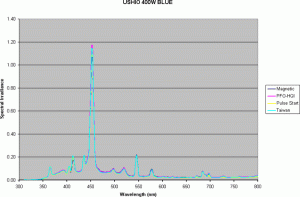
| Ballast | Power | Input Volts | Input Amp | PPFD | CCT |
|---|---|---|---|---|---|
| Standard (M59) | 451 | 118.3 | 4.13 | 109.9 | Out of range |
| Pulse Start | 445 | 118.5 | 4.20 | 102 | Out of range |
| PFO-HQI | 486 | 119.5 | 5.75 | 112.0 | Out of range |
| HQI-Taiwan | 450 | 120.1 | 4.05 | 106.5 | Out of range |
As seen from the data, there is very little variation in the output irrespective of the ballast used; however, the PFO-HQI ballast draws more current and about 10% more power. This lamp is very similar in spectral characteristics when compared to the Radium 400W 20000K lamp (see reference [1] for a spectral plot of the Radium lamp).
Sylvania Aqua Arc 400W
These lamps were listed on Hellolights.com and it was the first 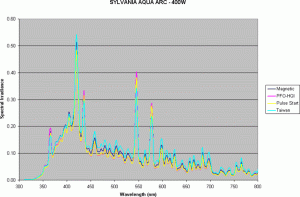 time we had heard of them. Table 4 shows the test data on this lamp as run on the 4 different ballasts.
time we had heard of them. Table 4 shows the test data on this lamp as run on the 4 different ballasts.
| Ballast | Power | Input Volts | Input Amp | PPFD | CCT |
|---|---|---|---|---|---|
| Standard (M59) | 438 | 117.8 | 3.81 | 146 | 10454 |
| Pulse Start | 447 | 118.4 | 4.11 | 132 | 10409 |
| PFO-HQI | 467 | 119.9 | 5.56 | 133 | 10335 |
| PFO-Taiwan | 480 | 119.3 | 4.32 | 162 | 10014 |
As seen from these plots, there is very little difference in the performance of the three ballasts – M59, Pulse Start, and PFO-HQI. The HQI-Taiwan ballast generated slightly more PAR, with most of the increase in the non-blue wavelengths, at the expense of higher power consumption. Overall, this seems like an excellent lamp. Major difference from the Ushio 10000K is the difference in the peaks – at 420 and 436 nm.
Aqualine 400 W 10000 K
| Ballast | Power | Input Volts | Input Amp | PPFD | CCT |
|---|---|---|---|---|---|
| Standard (M59) | 418 | 118.2 | 3.87 | 94.7 | 6616 |
| Pulse Start | 415 | 118.2 | 3.97 | 101 | 6995 |
| PFO-HQI | 485 | 119.0 | 5.56 | 133 | 9104 |
| HQI-Taiwan | 464 | 119.0 | 4.20 | 140 | 9481 |
Again, here it is quite obvious that there are two very similar groups of spectral output, with the M59 and Pulse Start Ballast having almost identical output, and the two “HQI” ballasts generating higher output with almost similar spectrums.
400W Vion Z6 and Xanium (Hellolights.com)
Recently Hellolights.com introduced the Vion Z6 and Xanium Series of lamps at attractive prices; this has piqued the interests of many hobbyists.
| Ballast | Power | Input Volts | Input Amp | PPFD | CCT |
|---|---|---|---|---|---|
| Standard (M59) | 436 | 119.3 | 3.93 | 66.92 | 6348 |
| Pulse Start | 418 | 118.5 | 4.11 | 69.4 | 6359 |
As you will see from the spectral plots, the Vion Z6 sold as a 10000K lamp appears as a poor imitation of the Ushio 10000K, with a lot less PAR and much lower color temperature. The output for the Vion Z6 is very similar for both the ballasts.
Xanium 400W
| Ballast | Power | Input Volts | Input Amp | PPFD | CCT |
|---|---|---|---|---|---|
| Standard (M59) | 467 | 119.4 | 4.22 | 100.1 | Out of range |
| Pulse Start | 428 | 119.0 | 3.82 | 94.4 |
This is an interesting lamp. Although it has a large spike in the 454 nm range like some of the other similar lamps (ALS and Blueline, see tests results in reference [5]) it has a better PPFD value when compared to these lamps. The PPFD values for the ALS and Blueline lamps were 66.84 and 71.60 respectively. This lamp is currently being marketed as a 15000K lamp, and like all the other lamps with predominantly blue color its CCT could not be calculated by the software.
175W AB 10000K Lamps
Two new 175W Aqualine lamps were also tested in an identical manner with the standard (M57) Magnetek Ballast and the venture Pulse Start ballast.
| Lamp | Power | Input Volts | Input Amp | PPFD | CCT |
|---|---|---|---|---|---|
| Lamp1 | 215 | 119.3 | 1.95 | 53.7 | 9269 |
| Lamp 2 | 213 | 120.3 | 1.92 | 64.4 | 11687 |
| Lamp | Power | Input Volts | Input Amp | PPFD | CCT |
|---|---|---|---|---|---|
| Lamp1 | 213 | 120.2 | 2.03 | 51.8 | 9269 |
| Lamp 2 | 208 | 119.9 | 2.04 | 60.7 | 12193 |
In addition, we tested two used 175W AB 10000K lamps that were used for 3200 hours over a period of eleven months. These lamps were driven by a pulse start ballast throughout their use. The owner indicated that he was very surprised that the inner arc tube had not blackened, and hence was very curious to know if the lamps were still useful. The data for these lamps is as follows:
| Lamp | Power | Input Volts | Input Amp | PPFD | CCT |
|---|---|---|---|---|---|
| Lamp1 | 212 | 119.4 | 2.04 | 50.8 | 8442 |
| Lamp 2 | 206 | 119.4 | 2.00 | 57.3 | 10011 |
Although the data is not statistically analyzable, a few points of observation can be made. The variation among the 2 new lamps was almost 20%, and variation between the used lamps was about 15%. The pulse start ballasts do not significantly impact the output of the lamps. But, the used lamps had PPFD values within the range of the new lamps tested. This could potentially imply that the Pulse Start Ballast is less severe on the lamp and has increased the lamp life. This would be very significant for the reef aquarist since it would increase the length of time the lamps could be used, and merits further study.
Conclusion
As new lamps and ballasts are being brought into the hobby, it has become increasingly difficult for hobbyists to keep up and know enough about these lamps and ballasts to make an educated choice. It is our hope that this series of articles will provide the hobbyists information to help them make an informed choice. The introduction of pulse start ballasts is intriguing especially if it helps in increasing the life of the lamps. Further long term studies would be needed to establish this. The effect of the “HQI” ballasts used on some lamps appears to be a higher output. They also run the lamps with more energy and their impact on lamp life is an open issue that will require further study.
Acknowledgements
We would like to thank several people whose help made this study possible. They were kind enough to provide us with lamps and ballasts for testing: Dave and Patrick at PFO Lighting, Brain at HelloLights.com, Brad at Aqua-Medic, Leonhard Ho and Roger Huff. Finally, we would like to thank Dr. Paul Walker of Penn State University for the use of the spectroradiometer and a dark room for testing the lamps.
References
- Joshi, S. 1998. Spectral Analysis of Metal Halide Lamps Used in the Reef Aquarium Hobby Part 1: New 400-watt Lamps, http://www.animalnetwork.com/fish2/aqfm/1998/nov/features/1/default.asp
- Joshi, S. and Morgan D. 1999. Spectral Analysis of Metal Halide Lamps Used in the Reef Aquarium Hobby Part II: Used 400-watt Lamps http://www.animalnetwork.com/fish2/aqfm/1999/jan/features/2/default.asp
- Joshi, S. and Morgan, D. 1999. Spectral Analysis of Metal Halide Lamps Used in the Reef Aquarium Hobby Part III: New and used 250-watt Lamps http://www.animalnetwork.com/fish2/aqfm/1999/dec/features/2/default.asp
- Joshi, S. and Morgan D., “Spectral Analysis of Metal Halide Lamps – Do Ballasts Make a Difference,” 2001 Annual Marine Fish and Reef USA, Fancy Publications.
- Joshi, S., “Spectral Analysis of Recent Metal Halide Lamps: Part IV– 10000K and 12000K lamps,” 2002 Annual Marine Fish and Reef USA, Fancy Publications.


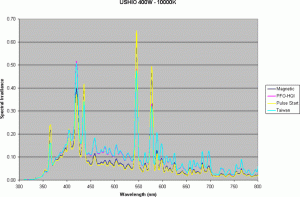
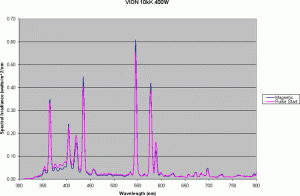
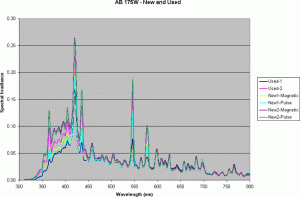

0 Comments